凝胶渗透色谱法(GPC)是一种非常有效的检测高分子等干扰脂质,例如蛋白质、色素和动物组织细胞的方法。
方案详情

Evaluation of Several Columns and Solvents forPost-Extraction Gel Permeation Chromatography (GPC) Clean-upof Fish Tissue Prior to PCB Analysis Keywords: Automated GX-271 GPC Clean-up System, Contaminants,EnviroSep-ABCGPC Sample Clean-upColumn,Fish, GC/ECD, Gel Permeation Chromatography (GPC),PCBs This study was performed in collaboration with the Wisconsin State Lab of Hygiene in Madison, WIandpresented at the 2009 SETAC North America Meeting in New Orleans, LA. Introduction The determination of PCBs, as well as other environmental contaminants, in fish tissuerequires extensive sample cleanup prior to analysis by gas chromatography with anelectron capture detector (GC-ECD). The high fat content of fish tissue can causebuildup of nonvolatile materials on the GC injection port and the analytical columnresulting in poor analytical results and high instrument maintenance costs. Gel Permeation Chromatography (GPC) is a size-exclusion clean-up procedure thatuses organic solvents and a hydrophobic gel (primarily a cross-linked divinylbenzene-styrene copolymer) to separate macromolecules. It is a highly effective method for theremoval of high molecular interferences such as lipids, proteins, pigments and cellularcomponents from animal tissue. GPC clean-up is often used for the clean-up of fish tissue extracts prior to analysis forhalogenated compounds such as PCBs and chlorinated pesticides. The most commonGPC clean-up procedures for fish extract cleanup utilize a 700 mm x 25 mm glasscolumn containing 70 g of Bio-Rad EnvirobeadsSX-3 resin with a mobile phase of100% dichloromethane or 60 g of Envirobeads SX-3 resin with a mobile phase of1:1 dichloromethane/cyclohexane at a flow rate of 5 mL/min.Although both columnsare highly efficient in removing lipids from fish extracts, sample throughput is limitedto approximately one hour per sample extract and both clean-up procedures utilizelarge amounts of solvent per sample. Gilson, Inc. World Headquarters|3000 Parmenter Street|P.O. Box 620027| Middleton, WI53562-0027,USA|Tel: 608-836-1551 or 800-445-7661| Fax:608-831-4451 The purpose of this study was to use a Gilson GX-271 Automated GPC Clean-upSystem (Figure 1) to evaluate several GPC clean-up columns and mobile phases thatwould give faster throughput and use less solvent for the post-extraction clean-up offish tissue prior to PCB analysis via GC-ECD. Figure 1. Gilson Automated GX-271 GPC Clean-up System with UV Detector(part number 21110000) ExperimentalConditions Materials All solvents were distilled in glass suitable for GC, HPLC, pesticide residues analysisand spectrophotometry. All reagents were ACS grade quality or better.GPC standardswere prepared according to USEPA Method 3640A and contained corn oil,bis(2-ethylhexyl)phthalate,methoxychlor, perylene and sulfur. Stock solutions of PCBsincluded Congeners BZ #14, BZ #65 and BZ #166 obtained from Ultra Scientific. Extraction Weigh 10 g of ground fish tissue in a beaker. Fortify with 1g corn oil and add 60 ganhydrous sodium sulphate and 230 mL dichloromethane. Spike with appropriatesurrogate PCB standards. Pour the mixture through a column containing Florisil toppedwith a 1 mL layer of anhydrous sodium sulphate. Collect eluent and evaporate to neardryness using a gentle stream of nitrogen. Reconstitute in 5 mL dichloromethane. GPCClean-up The following columns and conditions were employed for GPC clean-up: Table 1. GPC Clean-up Protocols Column Mobile Phase Flow Rate InjectionVolume OI Analytical glasscolumn with 60gEnvirobeads SX-3 1:1 dichloromethane/cyclohexane 5 mL/min 5mL PhenomenexEnviroSep-ABC Column(21x350mm) withquard column 1:1 dichloromethane/cyclohexane 5 mL/min 5mL PhenomenexEnviroSep-ABC Column(21x350mm) withquard column 100% dichloromethane 5 mL/min 5mL Jordi Flash GelFluorinated DVB (10 X250mm) with guardcolumn 100% dichloromethane 2 mL/min 1mL OI Analytical OptimaColumn packed with21g Envirobeads SX-3 1:1 ethyl acetate/cyclohexane 5 mL/min 1mL Column calibration used a GPC calibration standard (as described above), aGilson 112 UV Detector set at 254 nm and Gilson TRILUTION LC software withGPC Methods (See Figure 2). Based on the UV trace,column eluate was collectedjust after bis(2-ethlhexyl)phthalate elution and stopped after perylene elution. AfterGPC clean-up, collected fractions were further cleaned up with silica gel to remove anypesticides and then concentrated with a gentle stream of nitrogen and reconstitutedin appropriate solvent for GC analysis. Figure 2. An example of a Sample List using GPC methods in TRILUTION LC v2.1 GCAnalysis PCBs were analyzed with an Agilent HP5890-II GC with a DB5 column (60 m x 0.25 mm ID,0.1uM phase) configured with ECD. Results Table 2. GPC Column Parameters for Fish Extract Clean-up Column Dump Volume(mL) CollectVolume(mL) TotalRunTime Column LipidLoading Capacity OI Analytical Glass,1:1 DCM/CYX 100 110 60 min 1g EnviroSep-ABC,1:1 DCM/CYX 75 48 32 min 0.5 g EnviroSep-ABC,100% DCM 75 43 30 min 0.5 g Jordi FlashFluorinated DVB,100% DCM 18 22 30 min 0.05 g Optima Column,1:1CYX:ethyl acetate 45 60 28 min 0.2 g Figure 3. Chromatogram of a USEPA Method 3640A calibration standard using anEnviroSep-ABC column with a mobile phase of 100% dichloromethane.The flow rate is 5 mL/min with UV detection at 254 nm. Figure 4. Chromatogram of a USEPA Method 3640A calibration standard using an EnviroSep-ABC column with a mobile phase of 1:1 dichloromethane/cyclohexane.The flow rate is 5 mL/min with UV detection at 254 nm. Figure 5. Chromatogram of a USEPA Method 3640A calibration standard using an OIAnalytical Optima column with a mobile phase of 1:1 ethyl acetate/cyclohexane.The flow rate is 5 mL/min with UV detection at 254nm. ]254nm Figure 6.Chromatogram of a fish tissue extract during GPC clean-up using anEnviroSep-ABC column with a mobile phase of 100% dichloromethane at5 mL/min. Fraction collection time marks are noted. Table 3. PCB Recovery in Fish (n=3) Column Mobile Phase PCB BZ#14 PCB BZ#65 PCB BZ#166 OI Analytical Glass,60g Envirobeads SX-3 1:1 dichloromethane/cyclohexane 74.7 81.6 81.5 EnviroSep-ABC 1:1 dichloromethane/cyclohexane 80.5 86.8 92.9 EnviroSep-ABC 100% dichloromethane 87.9 86.7 91 Jordi Flash Fluorinated DVB 100% dichloromethane 61.1 58.8 62.9 O1 Optima Column,1:1 CYX/EA 1:1 ethyl acetate/cyclohexane 90 89 117.5 External Standard Report Figure 7. GC/ECD chromatogram of fish tissue extract after GPC clean-up showingPCB congeners. Conclusion GPC clean-up is a highly effective tool for removal of lipids and other high-molecularweight interferences prior to analysis for PCBs by GC/ECD. All tested columns wereable to separate the lipids in fish extracts from the PCBs. The traditional glass columnpacked with 60 g Envirobeads SX-3, 1:1 dichloromethane:cyclohexane achievedexcellent separation and had the highest lipid loading capacity. However, it utilizedthe most solvent and had the lowest throughput. The Phenomenex stainless steel EnviroSep-ABC column, using either of the mobilephases tested, had twice the throughput of the traditional column and used half theamount of solvent. It provided very good recoveries (82.5 to 92.9%) of the PCBs tested.This column has the advantage of easily switching to a different mobile phase, ifnecessary. Lipid loading capacity is approximately one half that of the traditionalcolumn. The OI Analytical Optima column with a 1:1 ethyl acetate/cyclohexane mobile phasewas also effective, but demonstrated more recovery variability between extracts andhad a lipid loading capacity of approximately 20% of the traditional glass column. The Jordi Flash Gel Fluorinated DVB column utilized the least amount of solvent buthad the lowest lipid loading capacities and the poorest recoveries (58.8 to 62.9%)compared to all the other columns tested. Throughput was the same as thePhenomenex column. GPC clean-up readilylends itself to automation and helps reduce GC maintenancecosts by preventing buildup on GC injection ports and columns. ( Envirobeads is a registered trademark of Bio-Rad Lab o ratories, Inc. ) EnviroSep is a trademark of Phenomenex Corporation. Florisil is a registered trademark of U.S. Silica Company. Optima is a trademark of OI Analytical Corporation. |ISOERTIFIEDGilson S.A.S.| avenue des Entrepreneurs| BP F-VILLIERS LE BEL, FRANCE|Tel:+() Fax: +() ww.gilson.com| sales@gilson.com|service@gilson.com|training@gilson.com Application Note ENV December The determination of PCBs, as well as other environmental contaminants, in fish tissuerequires extensive sample cleanup prior to analysis by gas chromatography with anelectron capture detector (GC-ECD). The high fat content of fish tissue can causebuildup of nonvolatile materials on the GC injection port and the analytical columnresulting in poor analytical results and high instrument maintenance costs.Gel Permeation Chromatography (GPC) is a size-exclusion clean-up procedure thatuses organic solvents and a hydrophobic gel (primarily a cross-linked divinylbenzenestyrenecopolymer) to separate macromolecules. It is a highly effective method for theremoval of high molecular interferences such as lipids, proteins, pigments and cellularcomponents from animal tissue.GPC clean-up is often used for the clean-up of fish tissue extracts prior to analysis forhalogenated compounds such as PCBs and chlorinated pesticides. The most commonGPC clean-up procedures for fish extract cleanup utilize a 700 mm x 25 mm glasscolumn containing 70 g of Bio-Rad Envirobeads® SX-3 resin with a mobile phase of100% dichloromethane or 60 g of Envirobeads SX-3 resin with a mobile phase of1:1 dichloromethane/cyclohexane at a flow rate of 5 mL/min. Although both columnsare highly efficient in removing lipids from fish extracts, sample throughput is limitedto approximately one hour per sample extract and both clean-up procedures utilizelarge amounts of solvent per sample.The purpose of this study was to use a Gilson GX-271 Automated GPC Clean-upSystem (Figure 1) to evaluate several GPC clean-up columns and mobile phases thatwould give faster throughput and use less solvent for the post-extraction clean-up offish tissue prior to PCB analysis via GC-ECD.
确定
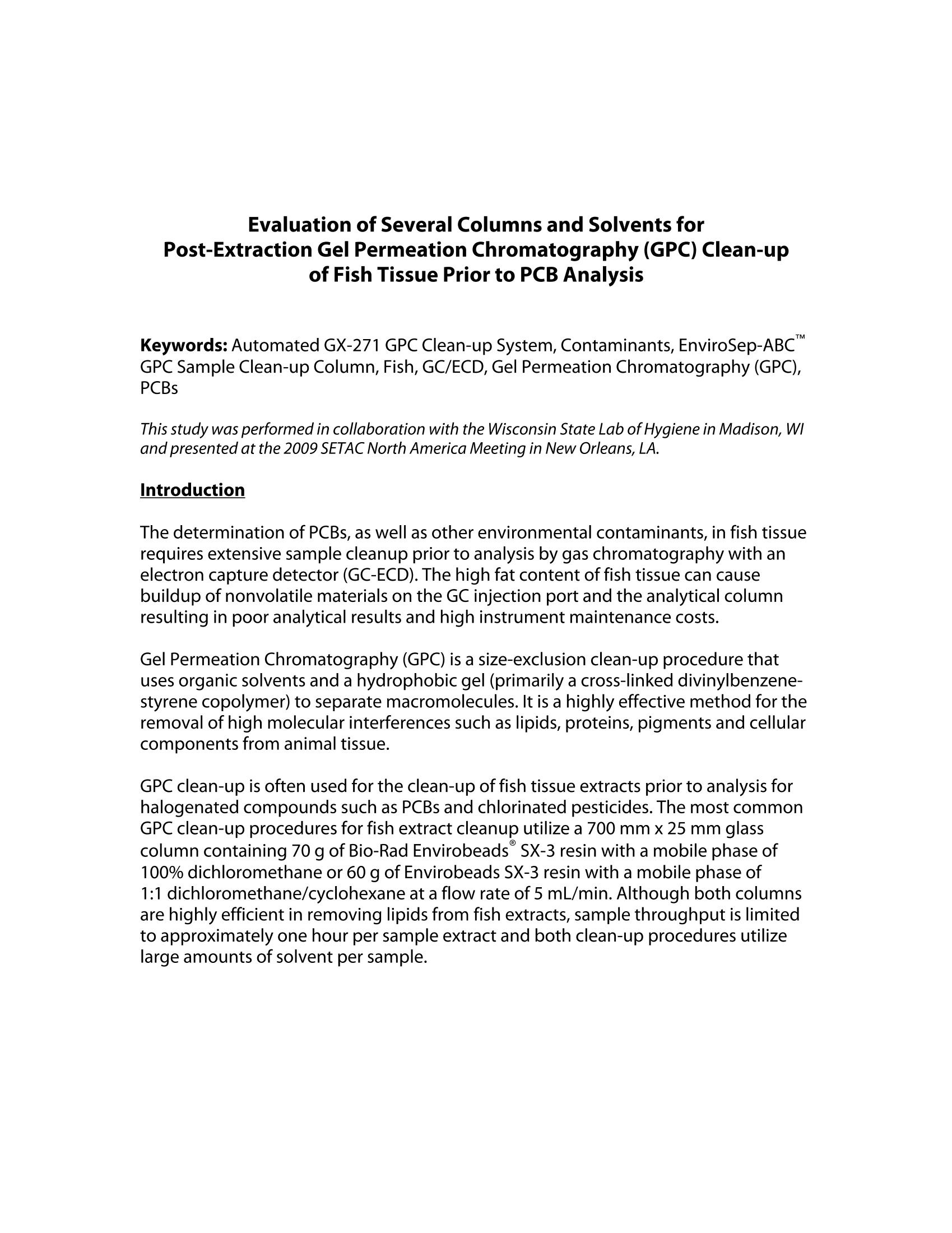
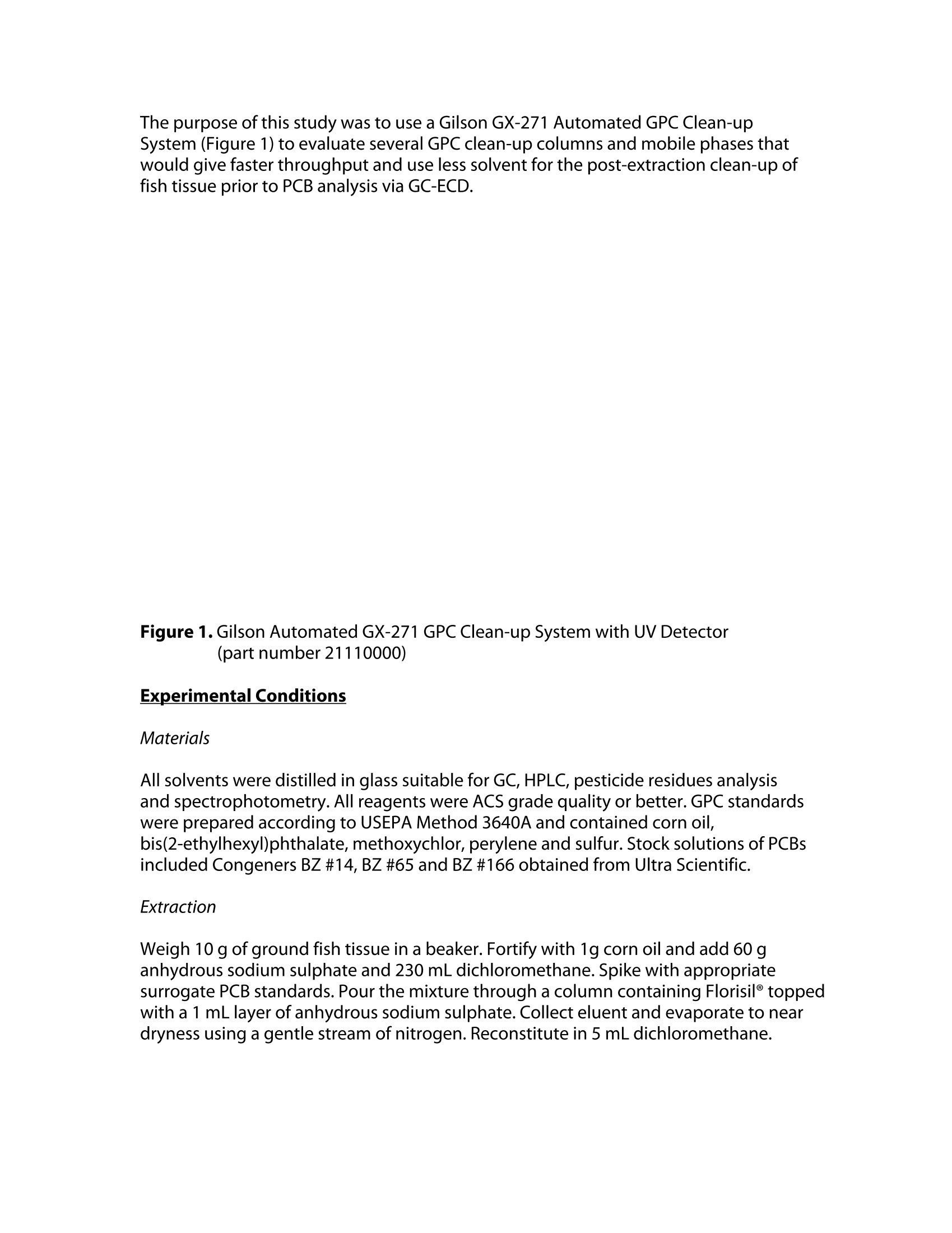

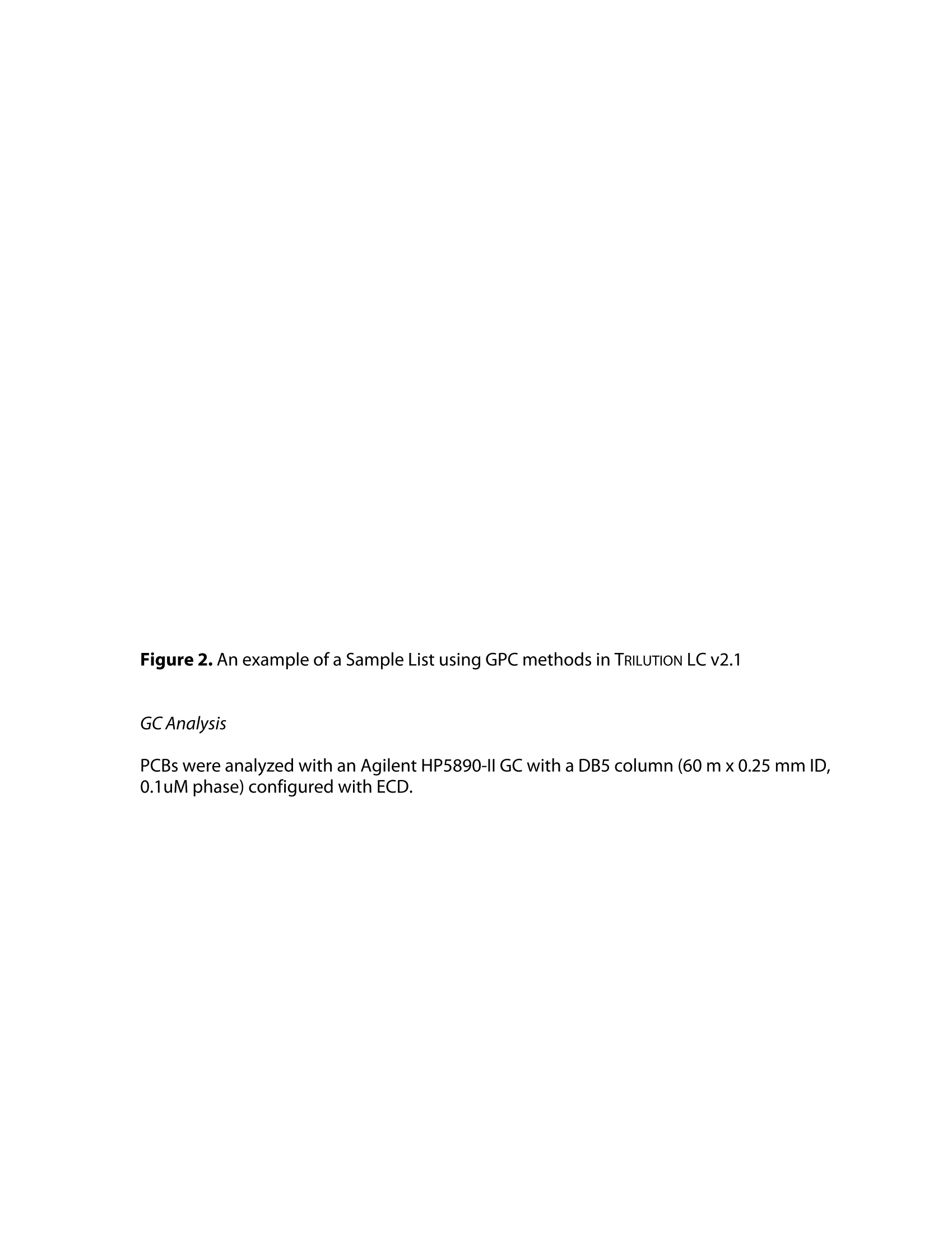
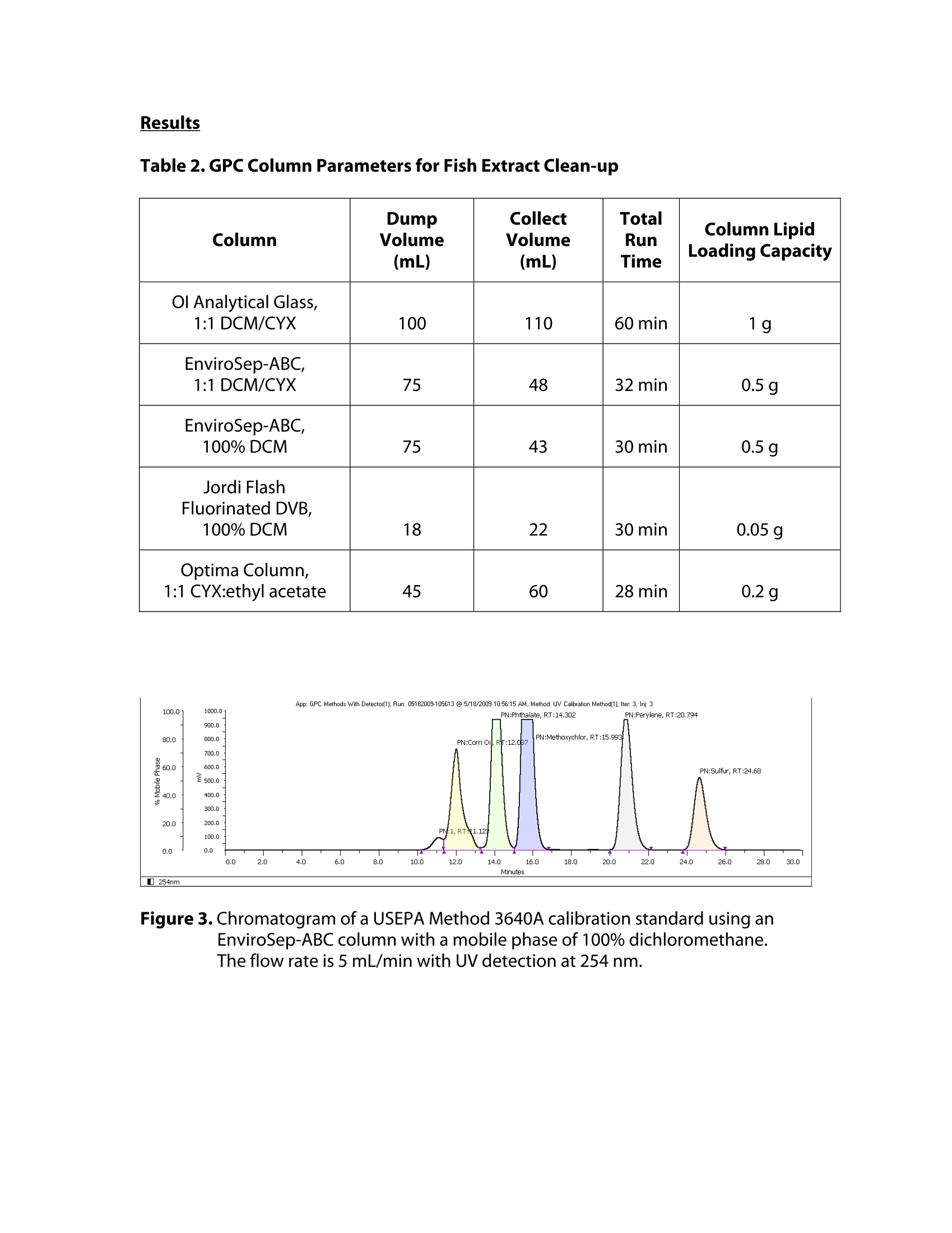
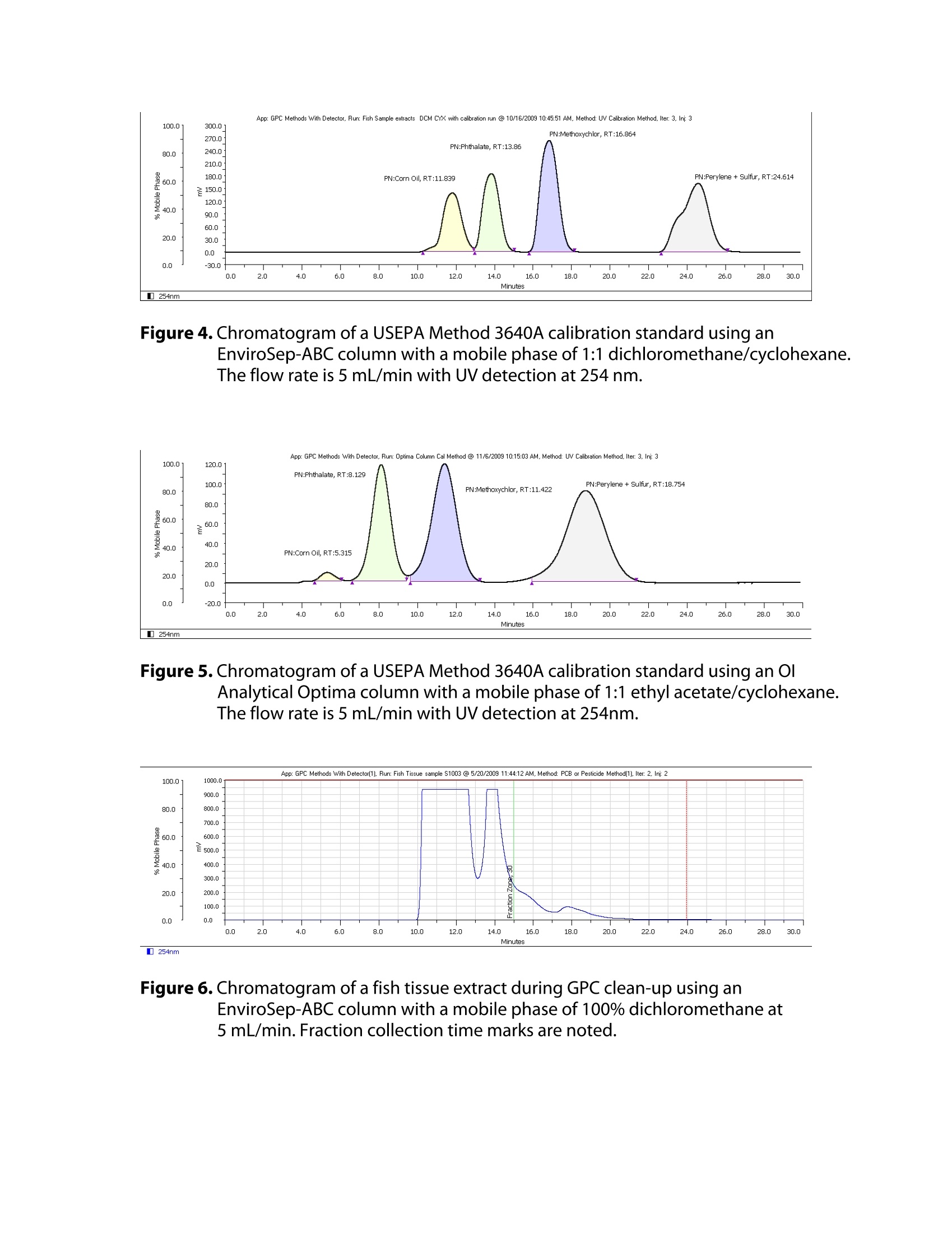
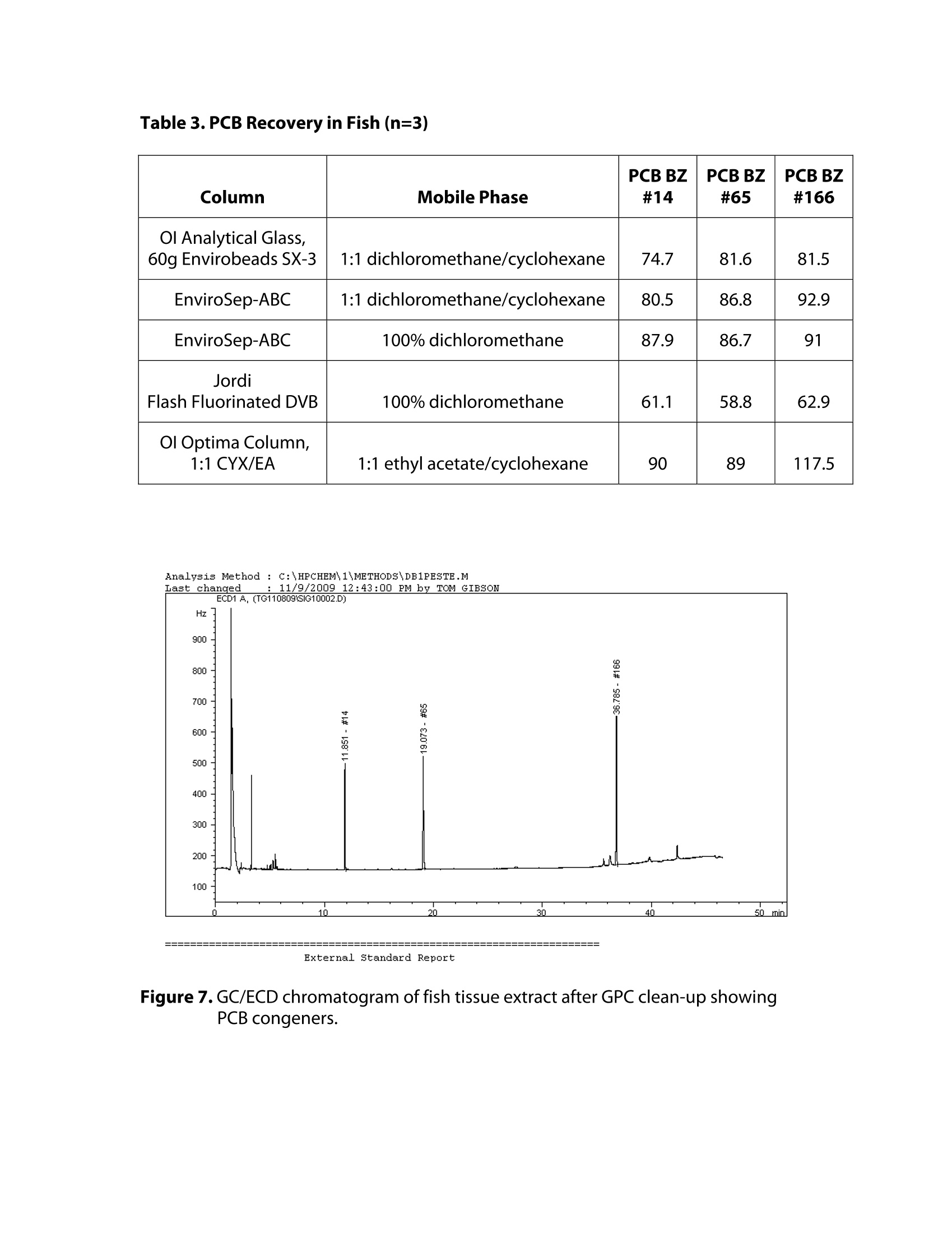

还剩6页未读,是否继续阅读?
香港华运有限公司为您提供《鱼类组织中多氯联苯(PCBs)检测方案(GPC)》,该方案主要用于水产品中环境污染物检测,参考标准--,《鱼类组织中多氯联苯(PCBs)检测方案(GPC)》用到的仪器有









